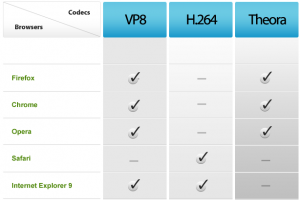 A codec is a device or computer program capable of encoding and/or decoding a digital data stream or signal.A codec encodes a data stream or signal for transmission, storage or encryption, or decodes it for playback or editing. Codecs are used in videoconferencing, streaming media and video editing applications. A video camera’s analog-to-digital converter (ADC) converts its analog signals into digital signals, which are then passed through a video compressor for digital transmission or storage. A receiving device then runs the signal through a video decompressor, then a digital-to-analog converter (DAC) for analog display. The term codec is also used as a generic name for a video conferencing unit.
A codec is a device or computer program capable of encoding and/or decoding a digital data stream or signal.A codec encodes a data stream or signal for transmission, storage or encryption, or decodes it for playback or editing. Codecs are used in videoconferencing, streaming media and video editing applications. A video camera’s analog-to-digital converter (ADC) converts its analog signals into digital signals, which are then passed through a video compressor for digital transmission or storage. A receiving device then runs the signal through a video decompressor, then a digital-to-analog converter (DAC) for analog display. The term codec is also used as a generic name for a video conferencing unit.
They’re used to convert the high-quality source material of a movie, for example, into compressed form that’s more easily transmitted over the Internet or stored on a Blu-ray disc. Then they’re used to convert that compressed data into something that people can watch or listen to again. The prevailing video codec today is called H.264, aka AVC, and for audio, it’s MP3. There are many others, however, including the AAC technology Apple uses for audio in iTunes and iPods, the Xiph.Org Foundation’s Ogg Vorbis audio codec and Ogg Theora video codec. Codecs can run in hardware or software, but hardware acceleration is particularly useful when trying to decode video quickly enough to handle high-resolution displays